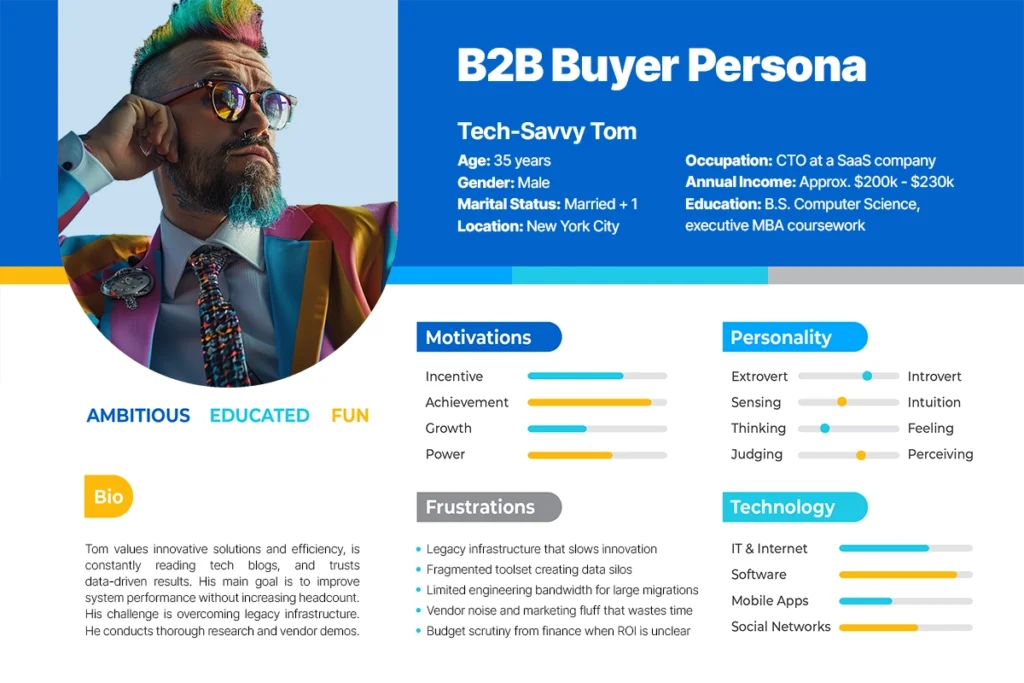Creating detailed B2B buyer personas is essential for aligning marketing and sales efforts with the right audience. Research shows that “knowing your B2B buyer persona is key to making informed sales and marketing decisions,” and many companies are prioritizing persona development to guide their strategy.
In a B2B context, buyer personas are semi-fictional profiles of the key decision-makers and influencers within target companies. These personas include firmographic data (company size, industry, revenue) and individual traits (role, goals, pain points) that shape how buying decisions are made. By understanding these profiles, marketing teams can craft targeted content and campaigns that directly address the needs of each role. For example, a persona might reveal that Tech-Savvy Tom, a CTO at a mid-sized software company, values technical demos and data-driven ROI analysis over generic sales pitches. Building such detailed personas ensures your messaging resonates with the right people. Moreover, targeting the wrong prospects can be expensive. Developing “negative personas” (profiles of unqualified or uninterested buyers) helps teams focus on productive leads and avoid wasted effort. With well-defined B2B buyer personas, companies can improve lead quality, close deals faster, and increase revenue.
Understanding B2B Buyer Personas

A B2B buyer persona is a semi-fictional representation of an ideal customer in a business context. It typically describes a decision-maker or influencer in an organization, focusing on their role, responsibilities, goals, and challenges. For example, a persona might outline a purchasing manager in a healthcare tech firm, noting their budget constraints, compliance concerns, and preference for data-rich case studies. B2B personas go beyond demographics to include firmographics (industry, company size, location), job roles, and buying criteria. These profiles help businesses understand who they are selling to and tailor their approach accordingly. In practice, creating a persona involves gathering data from customer interviews, CRM records, and market research to capture both quantifiable details (like company revenue) and qualitative insights (like personal motivations). This comprehensive view enables more precise targeting: companies with strong buyer personas report better alignment of marketing and sales efforts, higher conversion rates, and improved customer relationships.
B2B vs B2C Buyer Personas
B2B buyer personas differ significantly from B2C personas. A B2B persona represents a business professional making decisions on behalf of a company, whereas a B2C persona profiles an individual consumer. B2B purchases are typically rational and team-driven: decision-makers carefully evaluate ROI, scalability, and long-term benefits. They often involve multiple stakeholders (e.g., engineering, procurement, finance) and longer sales cycles. In contrast, B2C personas focus on personal demographics and emotional drivers (e.g., lifestyle, personal values).
For instance, a B2C campaign might appeal to a consumer’s desire for convenience or status, but a B2B campaign must address specific business challenges and regulatory requirements. Research notes that B2B personas “think strategically and act on behalf of their company, but they are also people who have personal goals and needs”. In other words, B2B personas require messaging that balances company-level benefits (efficiency, cost savings) with individual-level motivations (career success, risk aversion). Recognizing these differences ensures your marketing content and channels are chosen appropriately; weighing SEO vs PPC is a prime example of channel choice that varies by persona.
Key Persona Components
Effective B2B buyer personas combine several key components:

- Firmographic Data: Company attributes such as industry sector, company size (number of employees), annual revenue, and location. These details help segment which businesses are the best fit. For example, an ICP might target healthcare firms with 200-500 employees in North America.
- Job Role and Responsibilities: The persona’s title (e.g., CTO, Procurement Manager, Operations Director) and decision-making authority. This identifies whose needs you must address. Executives may focus on strategic outcomes, while managers may care about day-to-day efficiency.
- Goals and Objectives: Business goals that the persona aims to achieve, such as reducing costs, expanding into new markets, or improving security. Understanding goals enables you to position your solution as part of achieving them.
- Challenges and Pain Points: Problems the persona faces (e.g., outdated technology, tight budgets, regulatory compliance). For instance, a CIO persona may struggle with legacy systems that block innovation. By addressing these pain points, your messaging becomes immediately relevant.
- Buying Process and Criteria: Insights into the decision-making process, including evaluation criteria (cost, ROI, vendor reputation), sales cycle length, and approval process. For example, a persona might indicate that final approval requires sign-off from a CFO and legal team.
- Preferred Information Channels: The communication channels and content formats the persona trusts (industry publications, LinkedIn groups, professional events, etc.). B2B buyers often seek in-depth resources like white papers, case studies, and webinars.
- Psychographics and Motivations: Personal traits (e.g., tech-savvy vs. traditionalist) and motivations (desire for innovation, fear of obsolescence). A tech-savvy CTO persona may be excited by AI and automation, whereas a budget-conscious manager may prioritize cost-cutting solutions.
By compiling these elements, you can create a 360° profile of each buyer type. For example:
- Tech-Savvy Tom (Example Persona): Tom is a 35-year-old CTO at a mid-sized SaaS company in New York. He values innovative solutions and efficiency, is constantly reading tech blogs, and trusts data-driven results. His main goal is to improve system performance without increasing headcount; his challenge is overcoming legacy tech infrastructure. Tom conducts thorough research and seeks vendor demos with technical depth. An example persona infographic for someone like Tom is shown below. This chart illustrates how demographics (age, income), habits (reading tech literature), and goals (improving efficiency) come together in a visual format.

Persona sheets often include a photo or name (“Tech-Savvy Tom”) to humanize the data. By referring to “Tom” in marketing copy and sales conversations, teams align on a concrete image of the buyer. This example underscores how B2B personas capture both company factors and individual nuances.
B2B Buyer Persona Development
Developing a B2B buyer persona is a structured process. Follow these steps to build accurate, actionable personas:

- Define Your Objectives: Clearly articulate why you need each persona and refer to our ultimate guide to a marketing strategy for a step-by-step framework. Are you targeting new market segments or improving lead quality? Having clear goals guides the research scope and keeps the team focused.
- Gather Existing Data: Start by reviewing available information from customer databases, CRM records, website analytics, and social media interactions. Analyze patterns in your current customer base to identify common firmographic and behavioral traits. Competitive analysis can also highlight which segments are underserved.
- Conduct Qualitative Research: Interview customers, sales teams, and industry experts. Direct conversations uncover motivations and pain points that data alone can’t reveal. For example, speaking with current clients might reveal that slow onboarding times are a major frustration. Insights from these interviews are invaluable. Studies find that only interviewing actual buyers yields truly new insights compared to internal opinions or secondary research.
- Use Surveys and Social Listening: Deploy targeted surveys to a wider audience for quantitative backing. Questions should cover job role, decision criteria, and preferences. In parallel, social listening tools should be used to monitor industry discussions and sentiment. Analytics platforms (website logs, social media metrics) help validate persona segments based on content engagement and demographics.
- Identify Patterns and Segment: Synthesize your research to spot distinct segments. You might find, for instance, that one segment values cost-saving features while another prioritizes cutting-edge technology. Group customers into personas based on shared attributes and needs.
- Create Persona Profiles: For each segment, draft a persona document or template that feeds directly into your GTM strategy guide so every stakeholder sees the connection. Include a fictional name and picture, along with key details: company firmographics, role, objectives, challenges, preferred channels, and messaging strategies. Ensure consistency by using a standard template (many firms use downloadable persona templates). This makes it easy to compare personas and ensures no critical information is missed.
- Validate with Stakeholders: Review draft personas with sales, support, and marketing teams. Incorporate their feedback to fill gaps. For example, sales reps might suggest adding details about approval hierarchies that were overlooked.
- Monitor and Refine: Once used in campaigns, track performance metrics (leads generated, conversion rates, content engagement) tied to each persona. If one persona yields low ROI or engagement, revisit and adjust its profile. Persona development is iterative; update your personas regularly to reflect market changes and new data.
By following these steps, your team develops B2B buyer personas grounded in data and real-world insights. The resulting personas become the blueprint for targeted marketing, ensuring every campaign message resonates with the right decision-makers.
Integrating Personas into B2B Strategy
Well-crafted buyer personas should guide all aspects of your B2B strategy. Below are key ways to implement personas in marketing, sales, and lead generation:

- Marketing Campaigns: Use personas to tailor messaging and content, and invest in SEO services to make sure that content surfaces when your ideal prospects search online. If a persona research shows “Tech-Savvy Tom” prefers in-depth technical content, create whitepapers or webinars addressing his engineering concerns. If another persona values quick ROI, direct them to Google Ads management services for B2B companies that can deliver measurable results fast. Personas also inform channel selection: a finance executive persona might respond better to LinkedIn newsletters, while an operations manager might engage with industry forums or trade publications. Targeted campaigns based on persona data typically see higher engagement and ROI. For example, one study found that marketing initiatives aligned to personas significantly increase return on marketing spend, as messaging directly speaks to buyer goals and pain points.
- Sales Approaches: Train sales teams on persona specifics. Sales reps can customize their pitch angle based on the buyer’s role. For instance, with a CFO persona, emphasize the total cost of ownership and compliance; with a CTO persona, highlight technical features and ease of integration. Knowing a persona’s decision criteria lets sales prepare appropriate documents (ROI calculators, technical specs) in advance. Role-playing exercises using persona profiles can help reps practice adapting their conversation style. This person-centered approach often shortens the sales cycle and improves close rates, since prospects feel understood.
- Lead Generation & Nurturing: Personas sharpen lead qualification. Use ICPs and personas together: first filter prospects by ICP (company fit), then score leads by persona cues (job title, behavior). For lead nurturing, personalize email workflows by persona. For example, send a developer persona technical blog updates, but send a project manager persona monthly ROI reports. Over time, track which persona profiles convert best. Persona-based nurturing ensures leads receive the right content at each stage, keeping them engaged and moving through the funnel.
Adapting your strategy around personas creates consistent experiences: marketing messaging, sales conversations, and customer service all “speak the same language.” This alignment not only boosts efficiency but also builds trust with prospects, as every interaction reinforces that you understand their unique situation.
Monitoring and Updating Buyer Personas
Creating personas is not a one-time effort. Markets evolve, technologies change, and new data becomes available. To keep personas effective:

- Track Key Metrics: Measure campaign and sales outcomes by persona. Metrics like content click-through rate, email open rate, and conversion rate help assess if messaging resonates. For example, a high click-through on a persona-specific campaign indicates a strong match. Examine CRM data to ensure the profile demographics of converted leads match the persona’s intended profile (e.g., average deal size, industry). If certain metrics underperform, refine the persona: perhaps the target company size is too broad or an assumption about priorities was wrong.
- Watch Industry Trends: Stay alert to shifts in the market or buyer behavior. For instance, a new regulation might change buying criteria, or a disruptive technology could alter priorities. Update persona profiles to reflect these trends (e.g., add a new goal or challenge). Industry reports and thought leaders can signal these changes.
- Leverage Feedback Loops: Continuously gather input from sales and support teams. If sales says prospects are asking about a previously unknown issue, incorporate that into the persona. Similarly, customer feedback surveys can reveal emerging concerns.
- Use AI for Dynamic Updates: Artificial intelligence tools can automate persona refinement. AI-driven analytics can detect emerging customer segments and evolving behavior patterns. In fact, AI personas can adapt in real-time to new data, eliminating outdated assumptions. For example, Gartner reports that 80% of marketers find traditional segmentation inadequate, and AI-generated personas dynamically update as customer data changes. Implementing AI can help keep personas aligned with current market realities and personalize experiences more precisely.
By regularly reviewing persona effectiveness and industry changes, companies ensure their personas remain accurate guides. An up-to-date persona strategy prevents wasted budget on irrelevant leads and empowers teams to make decisions with confidence.
Advanced B2B Buyer Persona Strategies
Beyond basic personas, advanced strategies such as product differentiation can yield a competitive edge:

Negative Buyer Personas
Negative (exclusionary) personas define who not to target. These are profiles of prospects unlikely to convert, such as those with no budget, outside your target industry, or whose needs don’t align with your offerings. Identifying these personas helps refine marketing by excluding them from campaigns. For example, if a company repeatedly sees inquiries from a certain sector that never become customers, it can create a negative persona and block that segment from lead ads. Research notes that negative personas represent individuals unlikely to convert or engage. By focusing only on positive-fit personas, businesses improve ROI and save resources. Building a negative persona involves analyzing lost deals or unqualified leads to spot common traits, then adjusting targeting criteria accordingly.
Influencer Targeting
In B2B marketing, industry influencers and thought leaders play a growing role. Partnering with respected figures (e.g., a well-known IT analyst or a popular tech podcast host) can amplify your brand’s credibility among target personas. Influencers can help you reach niche audiences and add authenticity: 67% of B2B brands use influencer marketing to increase brand awareness, and 54% leverage it to boost credibility and trust. For example, co-creating a webinar with an industry expert can attract their followers while validating your message. When selecting influencers, ensure they resonate with your personas’ interests and values. Collaborations might include joint content, speaking events, or endorsements. Incorporating influencer insights into persona content also helps by aligning messaging with topics the target audience respects.
AI-Assisted Personas
Artificial intelligence is revolutionizing persona development. AI tools can analyze massive datasets from website behavior and purchase history to social interactions to uncover hidden persona segments and preferences. Unlike static personas built on assumptions, AI-driven personas evolve with new data. For example, machine learning can reveal that a subset of your audience regularly compares prices on your site, prompting a “bargain-seeker” persona. AI can also personalize content in real time: platforms exist that use AI personas to automate messaging adjustments based on user behavior. McKinsey reports that personalized experiences driven by AI can increase revenue by up to 15%. By leveraging AI, marketers create dynamic personas that reflect current customer trends, enabling ever-more precise targeting and higher engagement.
These advanced techniques include negative personas to cut waste, influencers to build trust, and AI to continuously refine insights, extending the value of personas beyond traditional segmentation. Together, they ensure B2B companies stay agile and targeted in an increasingly complex market.
FAQ

A B2B buyer persona is a semi-fictional profile of an ideal customer’s role and characteristics in a business setting. It includes details like job title, company size, goals, and pain points. Personas are important because they help marketers and sales teams tailor messaging and strategy to real customer needs, improving engagement and conversion.
Start by defining who you want to target and gathering data. Use market research, website analytics, surveys, and especially interviews with real customers and sales reps. Identify common traits and motivations from this data. Create a persona document with sections for firmographics, goals, challenges, and buying criteria. Finally, validate and refine the persona with team feedback and performance metrics.
An ICP describes the perfect type of company (account) for your offering, focusing on firmographics like industry, company size, and revenue. A B2B buyer persona describes the people within those companies (their roles, needs, and preferences). In practice, you might use your ICP to identify target accounts, then use buyer personas to guide how you engage individuals at those accounts.
Negative personas (exclusionary personas) are profiles of unqualified or disinterested customers you want to avoid. Examples include companies that can’t afford your product or lead queries that don’t match your ICP. By defining these, you can exclude them from marketing campaigns, save on the budget, and focus on leads that are more likely to convert.
AI can analyze large datasets (customer behavior, social data, etc.) to dynamically refine personas and uncover insights humans might miss. AI-driven personas adapt in real time as new data comes in, ensuring they stay accurate. For example, AI can identify emergent buyer segments or preferences, and personalized AI models can tailor content delivery for different personas. This leads to smarter targeting and better ROI.
Final Words

In the B2B data-driven world, buyer personas are the cornerstone of focused marketing. They bridge the gap between generic campaigns and the specific needs of real buyers, enabling personalized engagement that drives results. By following a structured development process from research and segmentation to continuous refinement, companies ensure their personas remain relevant.
Advanced tactics like negative persona exclusion, influencer partnerships, and AI-powered analysis further sharpen this toolset. Ultimately, a robust persona strategy aligns marketing, sales, and product teams around a clear vision of the ideal customer. As markets and technologies change, regularly revisiting and updating your personas will keep your messaging effective. For B2B organizations without in-house expertise, seeking help through fractional CMO services can accelerate persona creation and integration. Alternatively, you can hire a fractional CMO to accelerate your B2B growth without the overhead of a full-time executive. With the right personas, businesses attract high-quality leads, boost conversion rates, and make every marketing dollar count.